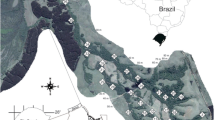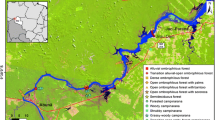Abstract
Riverine forests in west-central Florida were inventoried in 27 transects collectively 6 km long and consisting of 791 contiguous quadrats comprising 4.6 ha. The flora consisted of 409 species (292 terrestrial herbs, 84 trees and shrubs, 19 woody vines, 14 epiphytes). The average forest stand contained 496 trees/ha with a collective basal area of 24 m2/ha and a canopy height of 16 m. Cluster analysis allowed the recognition of 5 communities: 2 hydric (bay swamp, river swamp) and 3 mesic (wet-mesic, moist-mesic, dry-mesic), all dominated by hardwoods and sometimes cabbage palm. Each community conformed with topographic and moisture conditions. Several evidences, including comparisons of recent and older aerial photographs, showed that riverine forests have expanded laterally, presumably in response to reduction in fire frequency because of agricultural activities in uplands. Loblolly bay (Gordonia lasianthus), which typically is restricted to bottomlands, has colonized upland sites which have been free of fire for several decades. A laurel oak-red cedar-dogwood hammock is described. This ecotonal community between riverine forest and scrub or longleaf pine-xeric cak may represent an original vegetation type that developed where topographic irregularities prevented frequent fires.
Similar content being viewed by others
Literature Cited
Clewell, A. F. 1981a. Vegetational restoration techniques on reclaimed phosphate strip mines in Florida. Wetlands 1: 158–170.
Clewell, A. F. 1981b. Natural setting and vegetation of the Florida panhandle. Report Prepared under Contract No. DACW01-77-C-0104, Engineers, Mobile, AL. 773 pages.
Coultas, C. L., A. F. Clewell, and E. M. Taylor, Jr. 1979. An aberrant toposequence through a titi swamp. J. Soil Sci. Soc. Amer. 43: 377–383.
Hebb, E. A., and A. F. Clewell. 1976. A remnant stand of old-growth slash pine in the Florida panhandle. Bull. Torrey Bot. Club 103: 1–9.
Laessle, A. M. 1968. Relationship of sand pine scrub to former shore lines. Quart. J. Fla. Acad. Sci. 30: 269–286.
Leitman, H. M., J. E. Sohm, and M. A. Franklin. 1983. Wetland hydrology and tree distribution of the Apalachicola River flood plain, Florida. U.S. Geological Survey, Water-Supply Paper 2196-A.
Monk, C. D. 1966. An ecological study of hardwood swamps in north-central Florida. Ecology 47: 649–654.
Shuey, A. G., and R. P. Wunderlin. 1977. The needle palm:Rhapidophyllum hystrix. Principes 21:47–59.
Soil Conservation Service. 1958. Soil survey, Hillsborough County, Florida. Series 1950, No. 3. U.S. Dept. Agriculture, Washington, D.C.
U.S. Geological Survey. 1980. Water resource data for Florida. Vol. 3A-1. Southwest Florida surface water. Water-Data Report FL-80-3A-1.
Watts, W. A. 1971. Postglacial and interglacial vegetation history of southern Georgia and central Florida. Ecology 52: 576–690.
Wharton, C. H., H. T. Odum, K. Ewel, M. Duever, A. Lugo, R. Boyd, J. Bartholomew, E. DeBellevue, S. Brown, M. Brown, and L. Duever. 1977. Forested wetlands of Florida — their management and use. Florida Division State Planning DSP-BCP-19-77.
White, W. A. 1970. The geomorphology of the Florida peninsula. Fla. Bur. Geol. Bull. No. 51.
Author information
Authors and Affiliations
Rights and permissions
About this article
Cite this article
Clewell, A.F., Goolsby, J.A. & Shuey, A.G. Riverine forests of the South Prong Alafia River System, Florida. Wetlands 2, 21–72 (1982). https://doi.org/10.1007/BF03160546
Issue Date:
DOI: https://doi.org/10.1007/BF03160546




